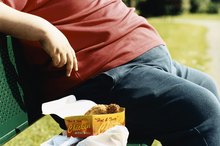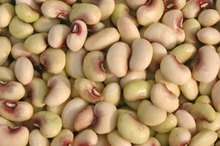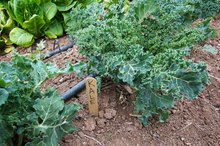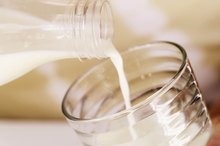What does fact checked mean?
At Healthfully, we strive to deliver objective content that is accurate and up-to-date. Our team periodically reviews articles in order to ensure content quality. The sources cited below consist of evidence from peer-reviewed journals, prominent medical organizations, academic associations, and government data.
- Harvard Health Publications: Abdominal Fat and What to Do About It
- Harvard Health Publications: Making One Change -- Getting More Fiber -- Can Help With Weight Loss
The information contained on this site is for informational purposes only, and should not be used as a substitute for the advice of a professional health care provider. Please check with the appropriate physician regarding health questions and concerns. Although we strive to deliver accurate and up-to-date information, no guarantee to that effect is made.
How to Reduce Stomach Fat With Kale and Cauliflower
There's no one food that's going to help you lose your stomach fat, and you can't selectively lose fat in one spot -- you can only reduce your overall body fat. But eating more nutrient-rich, low-calorie vegetables like cauliflower and kale can certainly help. The key to losing your belly is to eat a healthy diet that's low in sugar and high in fiber. Consult your doctor before starting any weight-loss diet.
Diet to Lose the Stomach
If you're trying to lose stomach fat, Rush University Medical Center suggests that you start by limiting your sugar intake by cutting out soda and juice 1. Instead, fill your diet with foods naturally high in fiber like fresh fruits and vegetables. You also want to eat more complex carbs such as whole grains and beans, as well as healthy polyunsaturated fats such as those found in salmon, walnuts and soy oil.
Kale, Cauliflower and Stomach Fat
How to Get a Flat Stomach and Bigger Breasts
Learn More
According to the medical center, it's the fiber in the kale and cauliflower that's going to help you trim your stomach fat. A 1-cup serving of cooked kale or cauliflower has 3 grams of fiber. Adding more fiber to your diet helps you lose weight, says Harvard Health Publications, and reduces your risk of heart disease and diabetes, two risk factors of excess belly fat 23. Rush suggests starting meals with a vegetable, such as a salad or vegetable-based soup, in addition to filling half your plate with veggies.
- According to the medical center, it's the fiber in the kale and cauliflower that's going to help you trim your stomach fat.
- Adding more fiber to your diet helps you lose weight, says Harvard Health Publications, and reduces your risk of heart disease and diabetes, two risk factors of excess belly fat 2.
Kale and Cauliflower Nutrition
It's not only the fiber in the kale and cauliflower that's good for belly fat. Both are low in calories, which can help reduce your calorie intake for overall weight loss, including your belly. A 1-cup serving of cooked kale has 36 calories, 0.5 gram of fat, 7 grams of carbs and 2.5 grams of protein. The same serving of cooked cauliflower has 28 calories, 0.5 gram of fat, 5 grams of carbs and 1 gram of protein.
The vegetables are also rich in nutrients that promote good health. Both are excellent sources of vitamin C, but kale is a better source of vitamins A and K and manganese.
- It's not only the fiber in the kale and cauliflower that's good for belly fat.
- The same serving of cooked cauliflower has 28 calories, 0.5 gram of fat, 5 grams of carbs and 1 gram of protein.
Serving Kale and Cauliflower
The Best Way to Reduce Visceral Belly Fat
Learn More
Nutrient-rich kale and cauliflower are both versatile veggies that make great accompaniments to any meal. You can use raw kale as the green for your salad or the cauliflower to make a cauliflower soup -- skip the milk and blend the cauliflower instead to make it creamy. Both kale and cauliflower also make good additions to any stir-fry or veggie saute. Or you can roast them in the oven with a little olive oil and pepper to bring out the flavor.
- Nutrient-rich kale and cauliflower are both versatile veggies that make great accompaniments to any meal.
- You can use raw kale as the green for your salad or the cauliflower to make a cauliflower soup -- skip the milk and blend the cauliflower instead to make it creamy.
Related Articles
References
- Rush University Medical Center: Is There Realy "One Trick" to Losing Belly Fat?
- Harvard Health Publications: Abdominal Fat and What to Do About It
- Harvard Health Publications: Making One Change -- Getting More Fiber -- Can Help With Weight Loss
- Cauliflower, raw. FoodData Central. U.S. Department of Agriculture. Published April 1, 2019.
- Slavin JL. Carbohydrates, dietary fiber, and resistant starch in white vegetables: Links to health outcomes. Advances in Nutrition. 2013;4(3):351S-5S. doi:10.3945/an.112.003491
- Moores CJ, Fenech M, O’Callaghan NJ. Telomere dynamics: The influence of folate and DNA methylation. Ann NY Acad Sci. 2011;1229:76-88. doi:10.1111/j.1749-6632.2011.06101.x
- Dahl WJ, Stewart ML. Position of the Academy of Nutrition and Dietetics: Health implications of dietary fiber. J Acad Nutr Diet. 2015;115(11):1861-70. doi:10.1016/j.jand.2015.09.003
- Pollock RL. The effect of green leafy and cruciferous vegetable intake on the incidence of cardiovascular disease: A meta-analysis. JRSM Cardiovasc Dis. 2016;5. doi:10.1177/2048004016661435
- Ahmed FA, Ali RF. Bioactive compounds and antioxidant activity of fresh and processed white cauliflower. BioMed Research International. 2013. doi:10.1155/2013/367819
- National Cancer Institute. Cruciferous vegetables and cancer prevention. Updated June 7, 2012.
- Scott O, Galicia-Connolly E, Adams D, Surette S, Vohra S, Yager JY. The safety of cruciferous plants in humans: A systematic review. J Biomed Biotechnol. 2012;2012:503241. doi:10.1155/2012/503241
- American Academy of Allergy Asthma and Immunology. Oral allergy syndrome (OAS) or pollen fruit syndrome (PFS).
- Bajaj JK, Salwan P, Salwan S. Various possible toxicants involved in thyroid dysfunction: A review. J Clin Diagn Res. 2016;10(1):FE01-3. doi:10.7860/JCDR/2016/15195.7092
- Cauliflower, pickled. FoodData Central. U.S. Department of Agriculture. Published April 1, 2020.
- Rice, white, cooked. FoodData Central. U.S. Department of Agriculture. Published April 1, 2019.
- Rice, brown, cooked. FoodData Central. U.S. Department of Agriculture. Published April 1, 2019.
- Riced cauliflower. FoodData Central. U.S. Department of Agriculture. Published April 1, 2019.
Writer Bio
Jill Corleone is a registered dietitian and health coach who has been writing and lecturing on diet and health for more than 15 years. Her work has been featured on the Huffington Post, Diabetes Self-Management and in the book "Noninvasive Mechanical Ventilation," edited by John R. Bach, M.D. Corleone holds a Bachelor of Science in nutrition.









